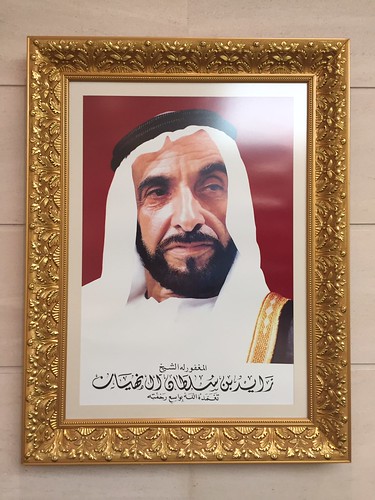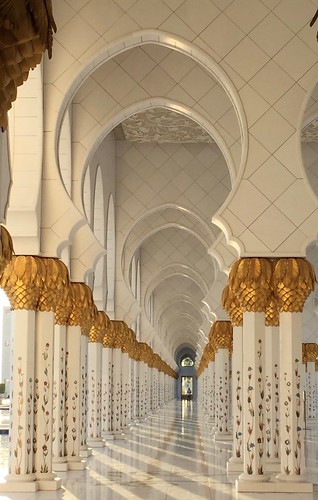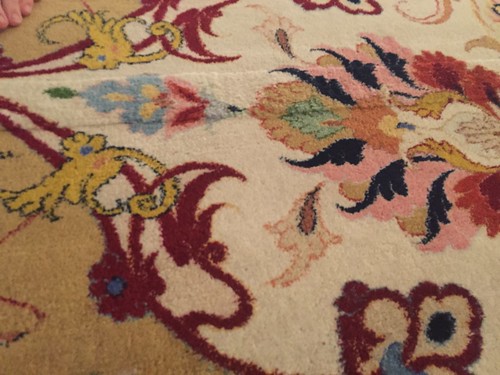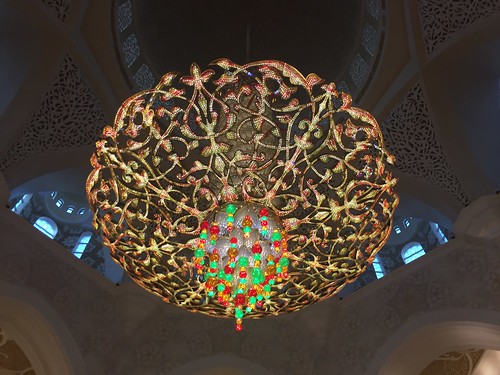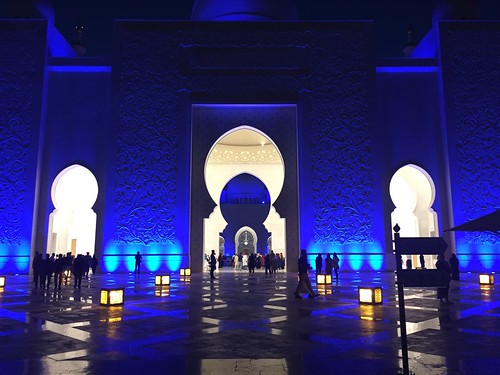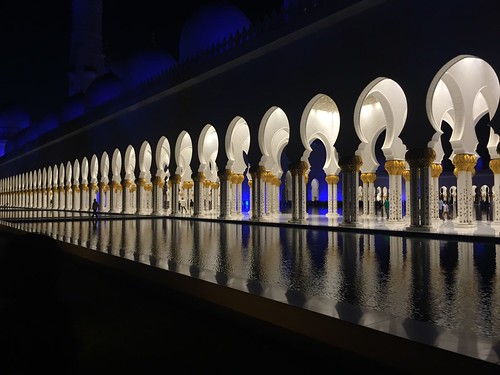I can’t tell whether I’m deluding myself, or whether I and the rest of the team actually kind of know how to do this stuff now, but last few weeks have been kind of ok. Rehearsals were not hectic. Our little workshop is up and running and building props. And a few of the bigger looming things are just the tiniest bit sorted out. This means that I actually had most of last Friday off. For those not familiar with working in the Middle East, Friday is the traditional day off here, because Friday Prayers have a special significance in Islam. So that means everything shifts and it’s not T.G.I.F but rather T.A.I.T!
I took advantage of the lack of rehearsals one Friday to go do something touristy, and visited the Sheikh Zayed Grand Mosque which is a very short drive from my hotel. The mosque is named for Sheikh Zayed bin Sultan Al Nahyan, the principal force behind the formation of the United Arab Emirates in 1971. Prior to that time the Emirates (there are seven) were independent Sheikhdoms in a protectorate treaty with the British. Sheikh Zayed was determined to bring the different sheikhdoms together into a union and headed up extensive talks that eventually resulted in the formation of the United Arab Emirates. He was the first President and is widely celebrated as the founding father of the country.
As always when visiting a mosque, it’s necessary to dress modestly so I was very careful to read the rules before going. I wore long pants and long sleeves and I brought a scarf. I checked with the Guest Services at the hotel before I left, and they assured me I’d be fine. And I checked again with a guard outside the entrance when I arrived… all good. This was all to avoid the dreaded “loaner abaya” that women have to wear if they are judged to be dressed inappropriately. An abaya is the female analogue to the men’s kandora, which astute GSWPL readers will remember from my last blog post. Abayas are normally black and cover the whole body except the head, hands and feet. In my opinion, a completely black (usually synthetic) full body garment is not the ideal clothing for a climate where temperatures rarely seem to go below 30 degrees but when in Rome... In contrast, Gerald, who went last week, was careful to hike his shorts up above the knee so he could be assigned a “loaner kandora”. (We have different priorities, Gerald and I…)
(Aside: Remember last time I mentioned that I’ve never seen a kandora that was less that pristinely white? Well I have now. Last week at the breakfast buffet I wheeled around to check out the action after hearing the unmistakeable sound of crockery hitting marble floor only to see one of my work colleagues flustering in front of an absolutely aghast looking man wearing a kandora with a bright orange smear down the front. What a drama!) (Another aside: Dear Autocorrect: Last week it was kangaroo. This week I can assure I don’t mean pandora. I mean pandora. No, dammit, pandora! Oh I give up…)
But back to the mosque. Despite all my precautions, when I finally entered the mosque grounds, the next guard I saw took one look at my apparently inappropriate outfit and said “Go get dressed”. This was disproportionately annoying to me, especially since as I looked around I could see several women dressed in tighter, shorter or more revealing clothes than I was wearing. Fuming, I descended to the underground parking garage, which was the unwelcoming route to the location where more appropriate coverings were dispensed. Women normally wear a scarf as a head covering, but the loaner abayas had a built in hood, which had the unsettling effect of making shorter women look very much like hobbits, so I elected to use the scarf I'd brought. Also, it was windy so keeping the hood up was annoying and the scarf stays up better. And no, I don’t have any photos.
Will I ever actually tell you about the mosque? Eventually yes, but there was more drama to come. Once I was suitably attired, I still had to wait around, silently fuming, waiting for a friend who was late in arriving. We were planning on doing the 5:00pm guided tour, and so I chose to wait near this sign:
When Iola finally arrived and got appropriately hobbited up, we asked around only to find out that the tour actually started in another section of the mosque and not “HERE” at all. We raced over to the actual starting place, only to find that the tour had already begun and was heading back to where we’d just come from. When we finally caught up we were blocked by a sort of gate-keeper kandora man who refused to let us join because we were late. There was another “latecomer” as well, who was passionately arguing with K-Man about how he should just let us join. This went on for a ridiculously long amount of time until I pointed out that the only reason we were late is because their signage was very misleading. I eventually explained the injustice of it all using the arabic words “hena” (here) and “henak (there) to point out how poor translation lead us astray. (Learned that in Egypt, I did). That seemed to be what finally broke his spirit because he let us join, though he flatly refused to give us the little headsets connected to the guide's wireless microphone. No matter, we just stood close by and it was all fine.
It’s actually quite stunning and much newer than expected. Built between 1996 and 2007, it was the vision of Sheikh Zayed, "who wanted to establish a structure which unites the cultural diversity of Islamic world, the historical and modern values of architecture and art” (Wikipedia, of course). Sadly, he died in 2004 so he never saw it completed. It’s the largest mosque in the Emirates and is the centre of worship for the country, accommodating 7,000 worshippers in the main prayer hall alone, and 40,000 in total when all the interior and courtyard space is used. It’s also quite well known for its architecture, which is supposed to be a blend of styles and materials from around the world.
Here are a few impressive facts: The mosque has four minarets, each 350 feet high. The courtyard covers 180,000 square feet and is covered in the largest marble mosaic in the world. There are 82 domes in total, and each is capped with a spire covered in gold glass mosaic tile. The largest dome is over a hundred feet in diameter.
When we got inside the main prayer hall, it was undeniably impressive. It’s only used for Friday noon prayers, Ramadan and Eid, which is a shame because it’s magnificent, with two main striking features. The first you see when you look down.
It is, in fact, the largest handmade carpet in the world. Measuring over 60,000 square feet, it was hand-knotted in Iran by more than a thousand women over the course of two years. It repeats the floral theme seen throughout the mosque in marble mosaic, inlay, bas relief and elsewhere. I might have chosen a different colour scheme, but they didn’t ask.
The carpet also shows an interesting feature:
The other most impressive feature of the main prayer room is the chandelier. It’s an unexpectedly modern design made from gilded metal and fitted with LED lighting. It’s also hung with Murano glass and Swarovski crystals and has a diameter of 33 feet, so it weighs in at an impressive twelve tons.
By the time our tour finished in the main prayer hall they were sounding the call to prayer and it was getting dark. We’d cleverly planned to arrive in daylight and leave in darkness so as to see the mosque in all lights. It’s impressive in the daylight, without a doubt, but they’ve also taken great pains to light it up beautifully at night. In fact, the lighting design is computer controlled and changes in relation to the phase of the moon, so it’s subtly different each night.
I took advantage of the lack of rehearsals one Friday to go do something touristy, and visited the Sheikh Zayed Grand Mosque which is a very short drive from my hotel. The mosque is named for Sheikh Zayed bin Sultan Al Nahyan, the principal force behind the formation of the United Arab Emirates in 1971. Prior to that time the Emirates (there are seven) were independent Sheikhdoms in a protectorate treaty with the British. Sheikh Zayed was determined to bring the different sheikhdoms together into a union and headed up extensive talks that eventually resulted in the formation of the United Arab Emirates. He was the first President and is widely celebrated as the founding father of the country.
Sheikh Zayed. His picture is everywhere here. And it’s almost always this one, which I think is quite flattering. I like how his fan belt is at a slightly jaunty angle. Plus the raised eyebrow makes him look a bit mischievous.
(Aside: Remember last time I mentioned that I’ve never seen a kandora that was less that pristinely white? Well I have now. Last week at the breakfast buffet I wheeled around to check out the action after hearing the unmistakeable sound of crockery hitting marble floor only to see one of my work colleagues flustering in front of an absolutely aghast looking man wearing a kandora with a bright orange smear down the front. What a drama!) (Another aside: Dear Autocorrect: Last week it was kangaroo. This week I can assure I don’t mean pandora. I mean pandora. No, dammit, pandora! Oh I give up…)
But back to the mosque. Despite all my precautions, when I finally entered the mosque grounds, the next guard I saw took one look at my apparently inappropriate outfit and said “Go get dressed”. This was disproportionately annoying to me, especially since as I looked around I could see several women dressed in tighter, shorter or more revealing clothes than I was wearing. Fuming, I descended to the underground parking garage, which was the unwelcoming route to the location where more appropriate coverings were dispensed. Women normally wear a scarf as a head covering, but the loaner abayas had a built in hood, which had the unsettling effect of making shorter women look very much like hobbits, so I elected to use the scarf I'd brought. Also, it was windy so keeping the hood up was annoying and the scarf stays up better. And no, I don’t have any photos.
Will I ever actually tell you about the mosque? Eventually yes, but there was more drama to come. Once I was suitably attired, I still had to wait around, silently fuming, waiting for a friend who was late in arriving. We were planning on doing the 5:00pm guided tour, and so I chose to wait near this sign:
Call me crazy, but I figured it was a good place to wait. (See hobbit in the back right...)
So… the mosque!
Here are a few impressive facts: The mosque has four minarets, each 350 feet high. The courtyard covers 180,000 square feet and is covered in the largest marble mosaic in the world. There are 82 domes in total, and each is capped with a spire covered in gold glass mosaic tile. The largest dome is over a hundred feet in diameter.
These pillars, and there are a zillion of them (actually one zillion seven hundred and thirty two, to be exact), are clad in marble and inlaid with floral designs. And the motif on the top is of palm leaves because, as I mentioned last time, date palm trees are a big deal here. Apparently it’s an offence to chop down a palm tree. If you do, you have to plant two new ones as compensation. Plus they ritually throw pickled beetroot at your nice white kandora. (Ok, I made one of those things up.)
Yes, it just looks like a carpet.
The carpet also shows an interesting feature:
See there’s a sort of extra-fuzzy line? The carpet is covered in parallel lines like this which allow the worshippers to line up in perfectly parallel rows, as is the custom. I think that’s very clever. Of course if they left this kind of thing up the theatre people they’d just end up with long worn out rows of layer on top of layer of crusty gaff tape.
The chandelier. And of course there are six other smaller ones throughout the mosque.
This is not a building that does things by halves.
This is not a building that does things by halves.
Sunset comes early these days, so though it was completely dark by the time we had our fill of white marble and mother-of-pearl inlay, it was still by no means late. Nevertheless, I resisted all efforts to get me to go out to dinner, headed straight back to my hotel room and treated myself to an early night of room service and videos and a cheesy novel and went to bed early. I think my brain is just tired these days, and spending what little free time have doing essentially nothing is exactly perfectly what I want.
Meaning, of course, that this post is over!
Meaning, of course, that this post is over!

